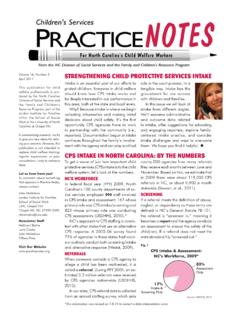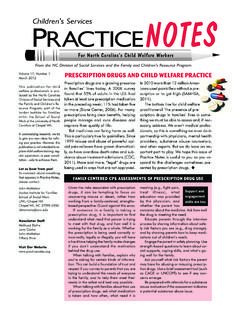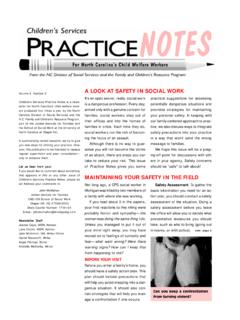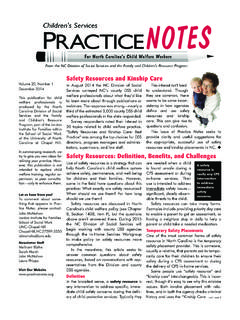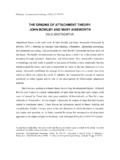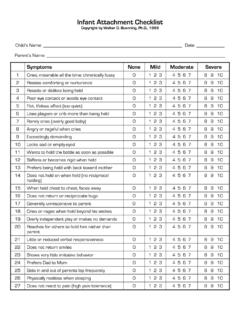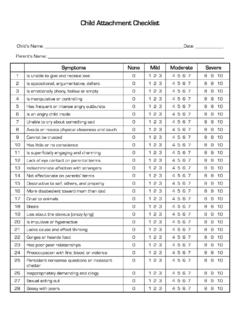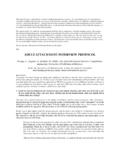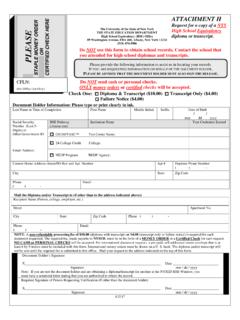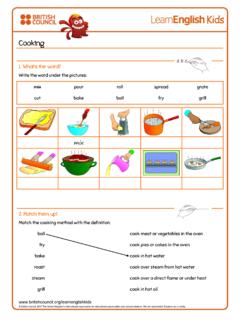Transcription of IN THIS ISSUE: SEPARATION AND ATTACHMENT
1 Volume 2, Number 4 Children s Services Practice Notes is a news-letter for North Carolina s child welfare work-ers produced four times a year by the NorthCarolina Division of Social Services and theFamily and Children s Resource Program, partof the Jordan Institute for Families and theSchool of Social Work at the University of NorthCarolina at Chapel summarizing recent research, we try to giveyou new ideas for refining your practice. How-ever, this publication is not intended to replaceregular supervision and peer consultation onlyto enhance us hear frLet us hear frLet us hear frLet us hear frLet us hear from you!om you!om you!om you!om you!If you would like to comment about somethingthat appears in this or any other issue ofChildren s Services Practice Notes, please doso!
2 Address your comments to:John McMahonJordan Institute for FamiliesUNC CH School of Social WorkChapel Hill, NC 27599-3550 State Courier Number: 14-24-11 Tel: (919) 962-6484. Fax: (919) : StafNewsletter StafNewsletter StafNewsletter StafNewsletter StaffffffJoanne Caye, MSW, AdvisorLane Cooke, MSW, AdvisorJohn McMahon, MA, EditorKaren Randolph, MSW, WriterIN THIS ISSUE: SEPARATION AND ATTACHMENTThe painful effects of SEPARATION andloss are experienced by children andtheir families, social workers, fosterparents, adoptive parents everyonetouched by child welfare social this issue of Practice Notes, welook at these powerful forces. Ourlead article defines SEPARATION andattachment, presents ways to help achild deal with SEPARATION , and out-lines the grief process that separa-tion so often page 4, we look at the dynamicbetween maternal substance abuseand infant ATTACHMENT ; we also pro-vide you with an assessment tool tohelp you decide whether to removean infant at this crucial page 6, we explore the influ-ence grief has on foster parent reten-tion.
3 Why do some foster parentsgrieve the end of a placement somuch that they stop fostering? Whatcan you do to help them?cont. page 2cont. page 2cont. page 2cont. page 2cont. page 2 EFFECTS OF ATTACHMENT AND SEPARATIONA ttachment and SEPARATION : these el-emental forces drive the behaviorsand decisions that shape every stageof practice. Assessment, removal,placement, reunification, adoption no aspect of child welfare social workis untouched by their influence. Thisarticle will describe these forces andprovide suggestions for helping chil-dren and families understand and copewith is the social and emo-tional relationship children developwith the significant people in theirlives.
4 An infant s first ATTACHMENT isusually formed with its mother, al-though in some circumstances an-other adult can become the primaryattachment figure. This may be a fa-ther, a grandparent, or an unrelatedadult (Caye, et al., 1996). ATTACHMENT is aprocess made up ofinteractions be-tween a child and hisor her primary care-giver. This processbegins at birth, help-ing the child developintellectually, orga-nize perceptions,think logically, develop a conscience,become self-reliant, develop copingmechanisms (for stress, frustration, fear,and worry), and form healthy and inti-mate relationships (Allen, et al., 1983).In her 1982 article on parent-childattachment, published in the journalSocial Casework, Peg Hess statesthat three conditions must be presentfor optimal parent-child ATTACHMENT tooccur: continuity, stability, and mutu-ality.
5 ContinuityContinuityContinuityContinuity Continuity involvesHow can you minimizethe trauma of placement?2 EFFECTS OF ATTACHMENT AND SEPARATIONthe caregiver s constancy and repeti-tion of the parent-child requires a safe environmentwhere the parent and child can engagein the bonding process. Mutuality Mutuality Mutuality Mutuality Mutuality re-fers to the interactions between theparent and child that reinforce theirimportance to each has demonstrated thattwo primary parenting behaviors aremost important in developing aninfant s ATTACHMENT to a ATTACHMENT occurs when acaregiver recognizes and responds tothe infant s signals and cues, meetingthe infant s physical and emotionalneeds; and when the caregiver regu-larly engages the child in lively of infants raised in institu-tional settings suggest that neither be-havior alone is sufficient for secureattachment.
6 For example, one studyfound that institutionalized infants failedto form strong attachments to care-immediate safety of the child. Throughthis SEPARATION , limits can be estab-lished for parental behavior, and thechild may get the message that soci-ety will protect him or her, even if theparent will not. SEPARATION also tem-porarily frees parents from the bur-den of child-rearing, allowing them tofocus on making the changes neces-sary for the child to return a parent and child canalso have profoundly negative when it is necessary, researchindicates that removing children fromHELPING A CHILD THROUGH A PERMANENT the child face the child face the child face the child face the child face reality.
7 The painneeds to be acknowledged and thegrieving process the child to expressEncourage the child to expressEncourage the child to expressEncourage the child to expressEncourage the child to There can be expressions ofreasons for the SEPARATION withoutcondemning the trell the trell the trell the trell the You can emphasize thathis parents were not able to take careof him without saying, Your mother isan alcoholic. Also, try to deal with thefantasy that children often have that theparents will return. The permanency ofthe loss needs to be the child to ask the child to ask the child to ask the child to ask the child to ask , be as truthful in your responsesas you can without hurting the lie to the child, even to sparesome with the child why the lossesProcess with the child why the lossesProcess with the child why the lossesProcess with the child why the lossesProcess with the child why the Ask about his ideas of why hehas made the moves he has andexperienced these time with the time with the time with the time with the time with the child.
8 Any child whohas experienced SEPARATION feelsrejection and guilt. This can interfere withhis sense of trust in others and spending time and talking with thechild, a new, trusting relationship can bebuilt between the worker and child duringpreparation. This, in turn, can lead toother healthy information about the information about the information about the information about the information about the child s identity is partly a result ofhaving a past that is continuous. Toachieve this continuity, varioustechniques, such as the Life Book, arevaluable. Social, cultural, and develop-mental information needs to beincluded in the book and made availableto the your own your own your own your own your own feelings.
9 It isdifficult to share the pain of separationand to be the one who helps the childface reality such as the fact that hemay never see his biological or fosterparents again. Often, the worker wouldprefer to avoid the pain and angryfeelings. However, if these feelings arenot dealt with now, they will recur andmay jeopardize : Fahlberg, V., Jewett, C., with contributionsby Buress, C., and Lopez, C., in Morton, Thomas, of children with special needs. Athens, GA:Office of Continuing Education, University of Geor-gia (developed under contract with the Children sBureau), 1982, pp. 9 11. Used with who readily mettheir physical needs but didnot engage them in socialinteraction.
10 Conversely,social interactions aloneare not enough: infants of-ten form social attach-ments to brothers, sisters,fathers, and grandparentswho engage them in plea-surable social activity. Yet,when they are tired, hungry, or dis-tressed, they often cannot be com-forted by anyone other than the car-egiver who has historically recognizedand responded to their signals of physi-cal and emotional need (Caye, et ).SEPARATIONS eparation, the removal of childrenfrom the caregiver(s) to whom they areattached, has both positive and nega-tive aspects. From a child protectionperspective, SEPARATION has severalbenefits, the most obvious being thefrom page 1from page 1from page 1from page 1from page 1 The success of a newrelationship isn t de-pendent upon thememory of an earlierone fading; rather thenew one is likely toprosper when the tworelationships are keptclear and distinct (Fahlberg, 1991).
